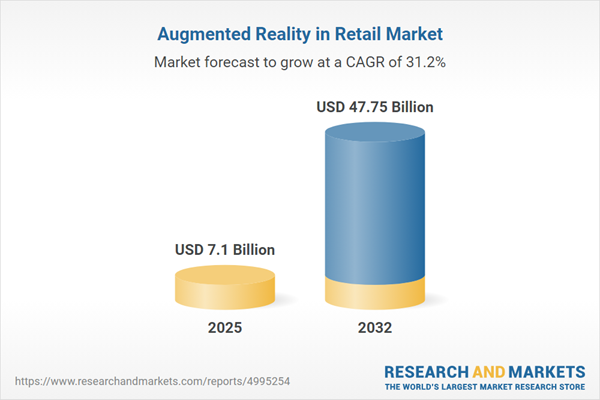Speak directly to the analyst to clarify any post sales queries you may have.
The Augmented Reality in Retail Market is experiencing accelerated growth as retailers increasingly leverage advanced AR technologies to transform consumer engagement, operational efficiency, and in-store experiences. This report delivers senior decision-makers targeted, data-driven insights on strategic opportunities and evolving dynamics within this rapidly shifting landscape.
Market Snapshot: Augmented Reality in Retail Market
The global Augmented Reality in Retail Market grew from USD 5.43 billion in 2024 to USD 7.10 billion in 2025. It is projected to expand at a CAGR of 31.21%, reaching USD 47.75 billion by 2032. Rapid technology adoption and evolving consumer expectations are fueling this robust upward trajectory, positioning AR as a pivotal capability in the future of omnichannel retail environments. Senior executives can capitalize on these market dynamics to strategically differentiate their brands and drive long-term value.
Scope & Segmentation of the Augmented Reality in Retail Market
This comprehensive report analyzes the implementation and impact of AR technologies across multiple dimensions, providing granular segmentation for actionable insights:
- Deployment Mode: Cloud-based solutions; On-premise architectures
- Device Type: Handheld; Head-mounted; Projection systems
- Product: Hardware (including displays, sensors); Services (maintenance & support, professional services); Software solutions (analytics, platforms, content management)
- End User: Cosmetics & beauty; Electronics; Fashion & apparel; Furniture
- Application: In-store navigation; Interactive marketing; Inventory management; Virtual try-on
- Regional Coverage: Americas (United States, Canada, Mexico, Brazil, Argentina, Chile, Colombia, Peru); Europe, Middle East & Africa (United Kingdom, Germany, France, Russia, Italy, Spain, Netherlands, Sweden, Poland, Switzerland, UAE, Saudi Arabia, Qatar, Turkey, Israel, South Africa, Nigeria, Egypt, Kenya); Asia-Pacific (China, India, Japan, Australia, South Korea, Indonesia, Thailand, Malaysia, Singapore, Taiwan)
- Company Profiles: Unity Software Inc., Apple Inc., Alphabet Inc., Microsoft Corporation, PTC Inc., Meta Platforms Inc., Adobe Inc., Snap Inc., Qualcomm Incorporated, Niantic Inc.
Key Takeaways for Senior Decision-Makers
- The integration of augmented reality technologies enhances both consumer engagement and operational effectiveness, bridging the gap between digital convenience and physical retail immersion.
- Strategic focus on cloud-based deployment enables scalability and rapid feature delivery, while on-premise architectures provide greater control for retailers with high security or latency needs.
- Retailers are leveraging tailored AR experiences for virtual try-on, showroom visualization, and interactive product demonstrations, increasing customer satisfaction and supporting data-driven personalization initiatives.
- Different device types address distinct operational requirements, from shopper-led mobile experiences to hands-free staff assistive tools and immersive group displays in showrooms.
- Sustained growth in the Asia-Pacific region is supported by strong smartphone adoption, robust digital infrastructure, and proactive government support, driving regional leadership in AR retail applications.
- Leading companies across hardware, software, and service domains are forming cross-sector partnerships to advance AR integration, expand analytics capabilities, and deliver comprehensive content management frameworks for multi-channel retailers.
Tariff Impact on Supply Chain and Cost Structures
Recent United States tariffs have created significant challenges in the AR retail supply chain, notably increasing hardware procurement and import-related costs. Both retailers and technology solution providers are adapting sourcing strategies, seeking geographic diversification and greater operational resilience. This also drives adjustments to cost models, including logistics, service agreements, and increased emphasis on software-driven solutions to mitigate hardware dependency.
Methodology & Data Sources
This report adopts a rigorous, dual-track approach—combining primary data from senior executive interviews and structured market surveys with secondary research from industry publications, conference proceedings, and technology roadmaps. Analytical models such as SWOT, PESTEL, and Porter’s Five Forces underpin validation and ensure relevance, with peer review by an expert advisory panel.
Why This Report Matters to Retail Decision-Makers
- Unlocks actionable segmentation insights to inform deployment, purchasing, and localization decisions that align with current trends in augmented reality in retail.
- Provides in-depth analysis of technological advancements, regulatory influences, and market leaders, allowing organizations to benchmark and shape resilient AR strategies suited to global or regional rollouts.
- Delivers concise synthesis of implementation learnings and strategic recommendations, supporting faster, lower-risk adoption of AR solutions with measurable ROI.
Conclusion
As augmented reality continues to redefine the contours of modern retail, organizations that invest in well-aligned, scalable AR adoption position themselves for sustainable competitive advantage. This report is designed to equip senior leaders with the insights to navigate disruption, harness evolving technologies, and drive transformative business outcomes.
Additional Product Information:
- Purchase of this report includes 1 year online access with quarterly updates.
- This report can be updated on request. Please contact our Customer Experience team using the Ask a Question widget on our website.
Table of Contents
3. Executive Summary
4. Market Overview
7. Cumulative Impact of Artificial Intelligence 2025
Companies Mentioned
The companies profiled in this Augmented Reality in Retail market report include:- Unity Software Inc.
- Apple Inc.
- Alphabet Inc.
- Microsoft Corporation
- PTC Inc.
- Meta Platforms, Inc.
- Adobe Inc.
- Snap Inc.
- Qualcomm Incorporated
- Niantic, Inc.
Table Information
| Report Attribute | Details |
|---|---|
| No. of Pages | 190 |
| Published | October 2025 |
| Forecast Period | 2025 - 2032 |
| Estimated Market Value ( USD | $ 7.1 Billion |
| Forecasted Market Value ( USD | $ 47.75 Billion |
| Compound Annual Growth Rate | 31.2% |
| Regions Covered | Global |
| No. of Companies Mentioned | 11 |









